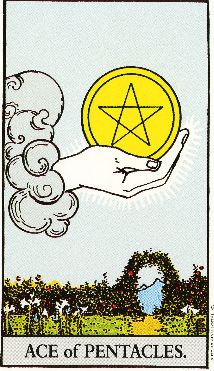Tarot - Robert von Heeren
The Minor Arcana of the Rider-Waite Tarot
Expressions of the four elements in ten levels of manifestation

reproduced by permission of U.S. Games Systems, Inc., Stamford, CT 06902 USA.
Copyright ©1971 by U.S. Games Systems, Inc. Further reproduction prohibited.
The Rider-Waite Tarot Deck® is a
registered trademark of U.S. Games Systems, Inc.
Visit the world's best source for tarot decks at: www.usgamesinc.com
The 40 minor arcana used to be called number cards, because before Waite they mostly showed only the quantitative number of the respective elements - as it is the case with today's playing cards. Only Waite gave them an individual and, as with the major arcana, ambiguous symbolism, which clearly enhanced the value of these so-called "minor trumps". Waite pretends in his "Picture Key" that the minor arcana are subordinate to the major arcana and are only meant for card reading. Nevertheless, they contain a much deeper symbolism: Caduceus (II of Cups), Grail (Ace of Cups), color and number symbolism and much more. Why this contradiction? For esotericists of that time it was typical and mostly intentional. Waite, in my opinion, knew very well that it is the very thing that attracts to a deeper study of the cards. I see in it something like "making a virtue out of necessity". As a board member and member of esoteric lodges he was subject to a vow of silence. He was not allowed to publish certain lodge knowledge. The obvious contradictions and mysterious hints are a (time-honored) pedagogical trick, a finger pointing to deeper meanings of the cards - without revealing them.
In any case, the systematic way in which Waite and Colman-Smith (her influence on the content of the card designs is probable, since she was also a lodge member) gave symbolic scenes and situations to the minor arcana is impressive. Thus, the 40 minor arcana can be seen as four independent cycles of manifestation in the Tarot, each from the One/Ace to the Ten. The cabbalistic references to the ten Sephira of the Tree of Life are unmistakable: the fourfold Tree of Life in the manifestations of the four elements. It even appears directly in the last card of the minor arcana: the X of coins/pentacles (it symbolizes the most solid form of manifestation, earth in earth).
Although each element series culminates in the Xer card and is self-contained, it can also be understood as a preparation and complement to the four court cards of the same element. Therefore, the 16 court cards are often added to the 40 minor arcana, so that most often we speak of 56 minor arcana. However, since the 16 court cards in the Tarot represent a small world of their own and have a different symbolic emphasis, I see them as a separate self-contained system.
Each series of the minor arcana is dedicated to one element: there are ten cards each of Wands=Fire, Cups=Water, Swords=Air and Pentacles=Earth. Waite thus saw these cards as more than just the quantitative accumulation of elements. He saw them as expressions of the ten energy spheres of the Kabbalistic Tree of Life, with the Aces at the top representing the highest and most immaterial origin energy sphere "Kether" (Crown, first Sephirot) of the Tree of Life, and the Tenth Cards representing the lowest, most material realization level "Malkuth" (The World Kingdom, the 10th Sephirot). Thus, the 40 minor arcana perform in a different way what the magician finds on his table in its original form: each of the four elements is a world in itself. And the Tree of Life exists in all four elements and therefore there are four Tree of Lifes, one for water, one for air, one for fire and one for earth. They correspond to the four Kabbalistic worlds of Atziluth, Beriah, Jetzirah and Malkuth. In combination with the ten manifestation levels of the Tree of Life, the total of 40 forms of appearance and development of creation are obtained. Waite connected the Tarot to this kabbalistic world systematically, especially in introducing motives related to the Tree of Life and the Sephirot into the previously "empty" 40 "number" cards / minor arcana. Besides of kabbalistic connections, he also put in many other symbols from alchemy, mythology of various cultures, astrology...
Waite has thus taken the minor arcana out of their shadowy existence as tarot accessories and formed them into the second, equal supporting pillar of his tarot artwork. The 22 major arcana form the first, the 16 court cards form the third and last pillar.